JWST compels us to ask: what’s wrong with Vega?

- Prominent in the night sky, Vega is among the brightest stars and happens to be young, close, blue, and still possessing a dusty debris disk around it.
- Augmenting previous observations by Hubble and ALMA, JWST’s MIRI instrument observed its face-on disk, finding a surprise: it’s smooth and symmetric, with barely any hints of planets at all.
- Unlike a very similar nearby star, Fomalhaut, Vega appears to be almost entirely structure-free. Perhaps it’s simply showcasing to us just how diverse planetary systems can be.
There’s a great sin that scientists all too often commit: by assuming, based only on a small number of examples (possibly as few as one), that the best scientific story we can reconstruct for those examples applies to all similar systems universally. Perhaps there’s no greater example of a field where this sin has been committed than in the science of exoplanets. Up until the early 1990s, we traditionally assumed that other planetary systems would be like our own: with inner, rocky planets, an asteroid-like belt, gas giant worlds, and then a Kuiper-like belt. Today, with thousands of exoplanets under our belt, we know of a huge variety of ways that this isn’t true:
- planets can be any mass and any distance from their parent stars,
- many super-Jupiter planets, as well as many planets between the mass of Earth and Neptune, abound,
- and that some stellar systems even have different numbers of belts than our own Solar System’s two.
Additionally, all stars don’t appear to have planets; just the ones that have sufficiently abundant fractions of heavy elements; planets become less common around stars with fewer than 25% of the heavy elements of our Sun, and are exceedingly rare around stars with less than 8% of the Sun’s heavy element content.
So what’s the deal, then, with Vega? It’s the 5th brightest star in Earth’s night sky. It’s young, at just 700 million years of age, and it still has a dusty debris disk around it. It has 32% of the Sun’s heavy elements content and about double the Sun’s mass. And yet, its debris disk is almost perfectly smooth and symmetric, showing scant evidence for any planet-formation or differentiation at all. The big question, now, is why?
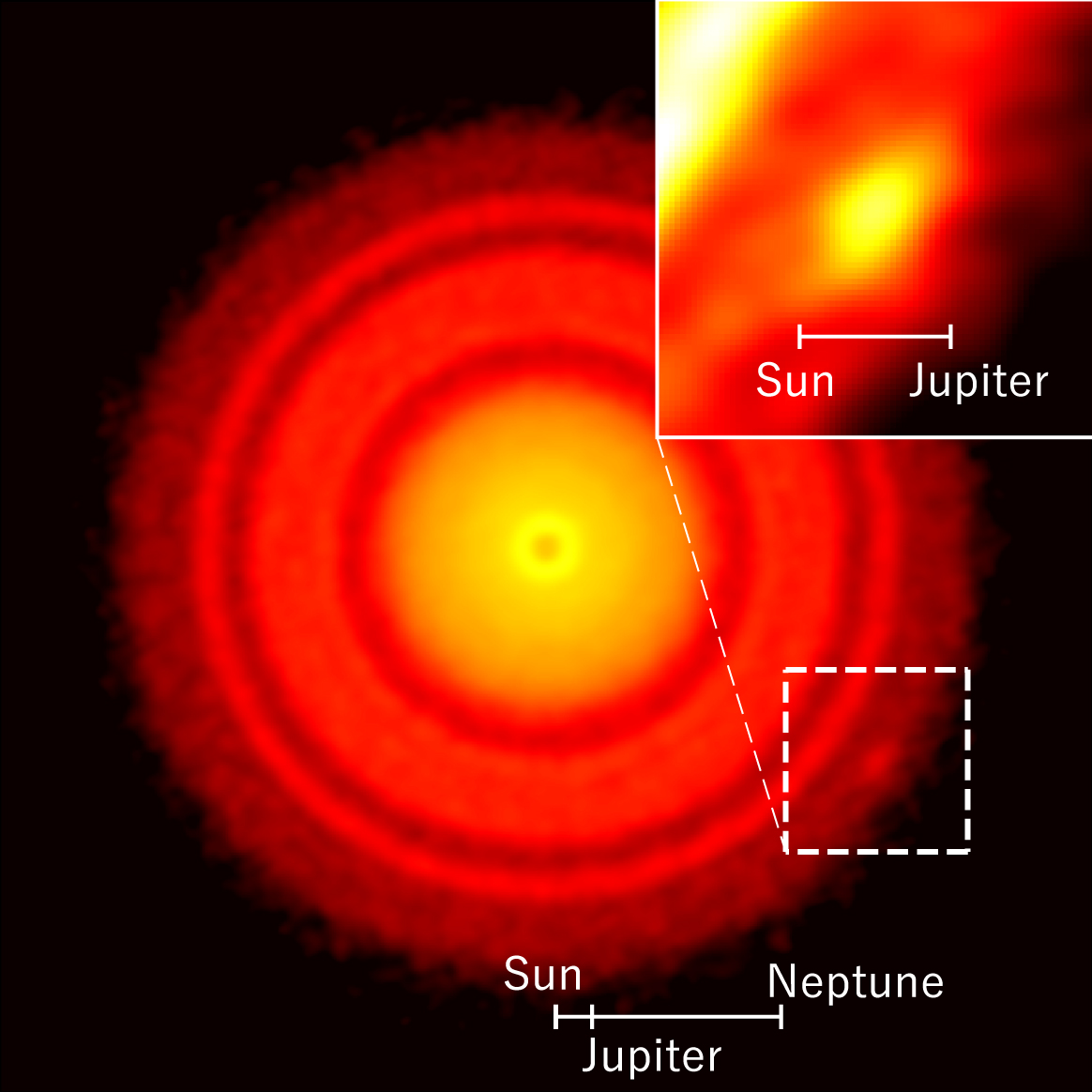
One of the most important questions we can ask of any physical system is whether we can tell a general story about systems like it that remain true across the wide variety of specific examples we can point to. With the advent of high-resolution infrared and radio imaging of newly-forming planetary systems, it appeared that a unified story emerged.
- First, from the moment a star ignites nuclear fusion in its core (and even before), a circumstellar disk of material appears to be present, and at least initially, is completely undifferentiated, smooth, and symmetric.
- However, asymmetries and differentiation typically begin to appear once the parent star is between 1-2 million years old.
- By the time a stellar system is between 2-10 million years old, differentiation features appear, and the planet-forming disk slowly tends to disappear over time.
- Finally, additional dusty debris persists within that young stellar system, resulting in not a protoplanetary disk, but a debris disk, which can persist for several hundred million or perhaps even up to a billion years after a star’s birth.
These disks around young stellar systems have been imaged spectacularly here in the 21st century, most notably by observatories like ALMA, which uses very long baseline interferometry to create radio maps of protoplanetary and debris disks, and by infrared observatories that operate from the ground as well as in space. Hubble and ground-based telescopes have done remarkable work here, but the real game-changer since 2022 has come with the advent of JWST: our spaceborne and infrared-specializing flagship observatory.
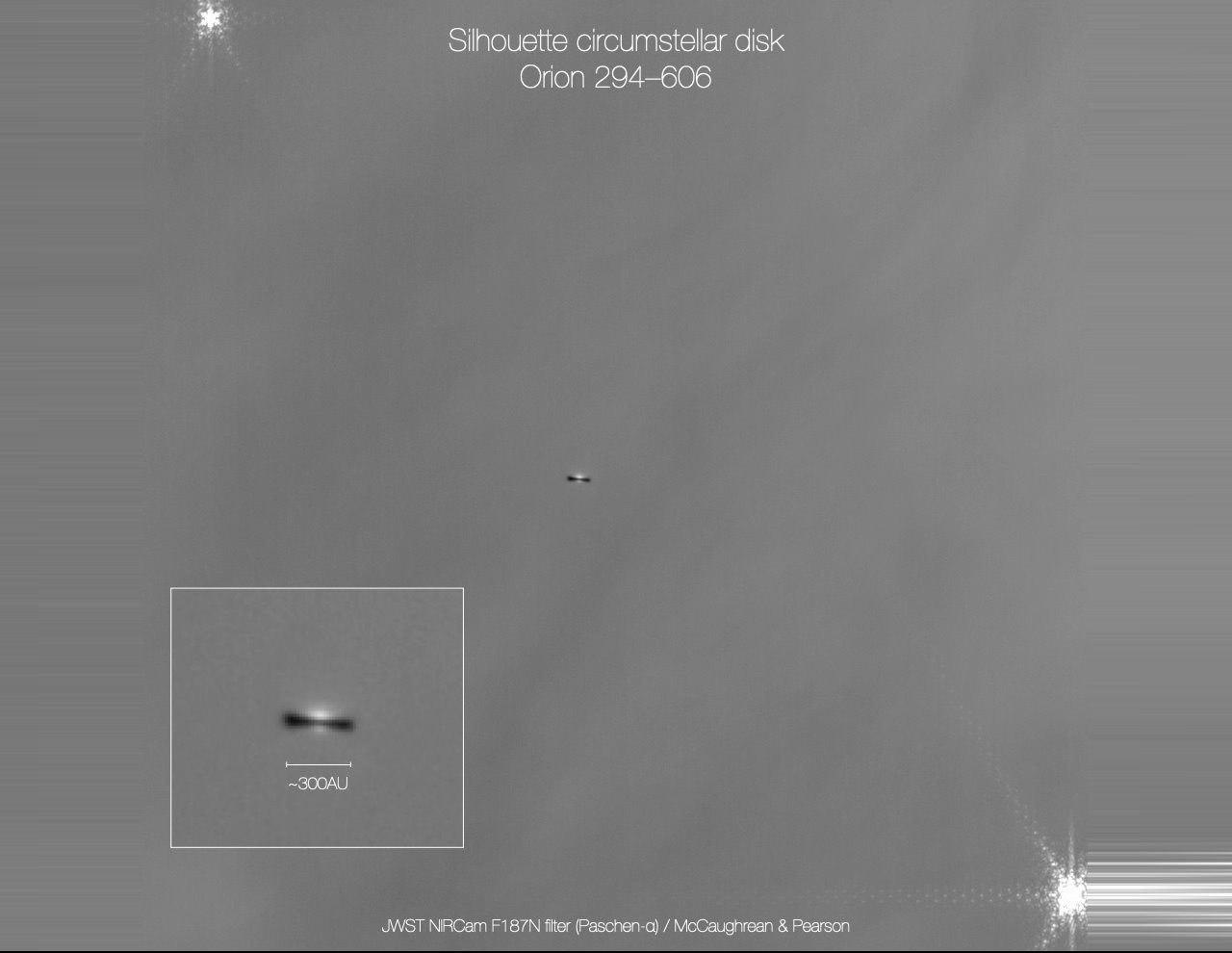
Perhaps the greatest surprise from the JWST era has come in exactly this arena. Previous observations of the young star Fomalhaut has revealed it has a large amount of dusty debris still around it: not too surprising when you consider that it’s only 440 million years old and extremely close by, at a distance of only 25 light-years. Fomalhaut is the brightest star in the constellation of Pisces and is overall the 18th brightest star in Earth’s night sky. Perhaps its most striking feature is a large ring of debris, first identified by Hubble and later confirmed by ALMA, that surrounds this star at a rather large distance: 133 astronomical units (where one astronomical unit is the Earth-Sun distance), or around triple the distance from the Sun to the Kuiper belt.
However, once JWST turned its infrared-specializing eyes onto the Fomalhaut system, particularly with the MIRI (mid-infrared instrument) camera, an enormous surprise emerged. Not only was there an inner disk region, corresponding to any inner planets and an asteroid-like belt, as well as the already-known outer disk (or outer ring) region, but there was a huge surprise inside: a third, intermediate belt, which again has gaps on the inside and outside of it, separating this ring or belt from the inner disk and the outer ring both. This discovery was completely unexpected, and served as a cautionary tale against making assumptions and extrapolations from “one, or a few” examples to “universal” without the needed supporting evidence.
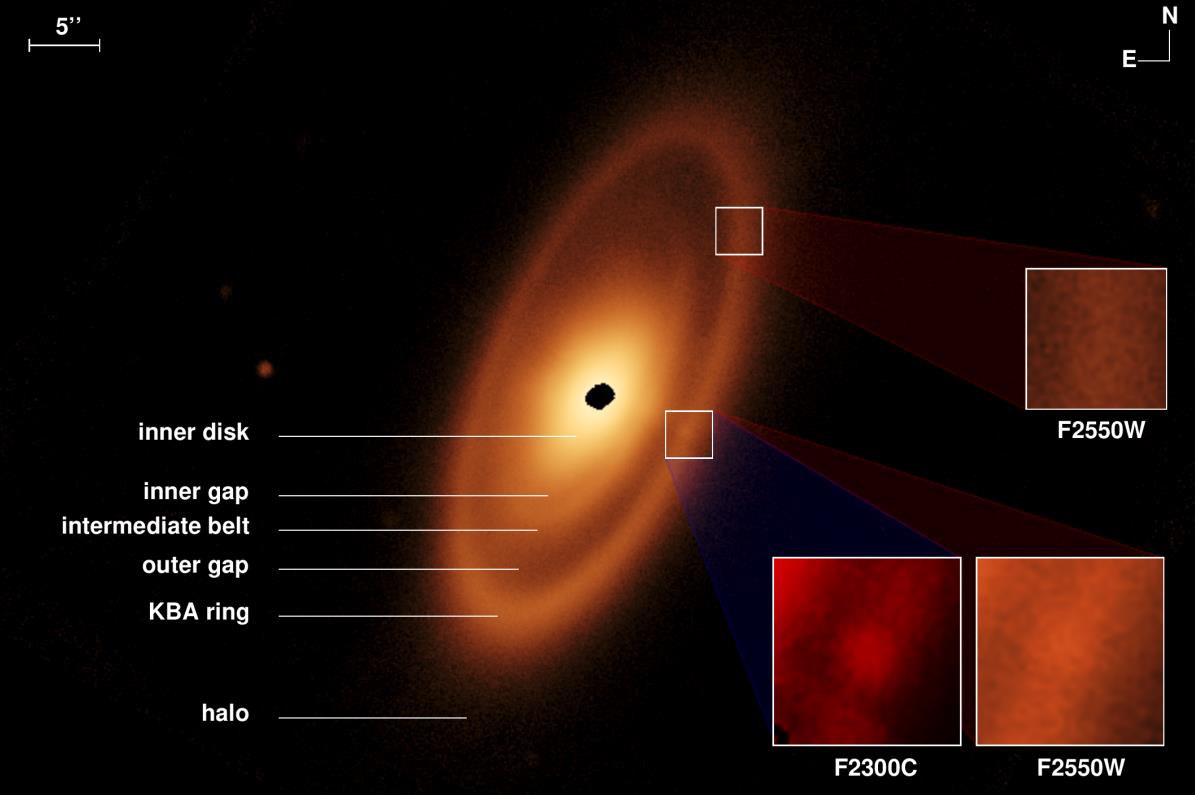
Of course, if you’re interested in Fomalhaut, then from an astronomer’s perspective, you should be interested in Vega as well. Vega and Fomalhaut are very similar in a lot of ways. Vega is the brightest star in its constellation, Lyra, and is actually the fifth brightest star in the entire night sky, surpassed only by Sirius, Canopus, Alpha Centauri, and Arcturus. Vega is also about double the mass of the Sun (2.15 solar masses, as opposed to Fomalhaut’s 1.92 solar masses), and is a little more luminous, larger in physical size, and hotter than Fomalhaut as a result. It’s also 25 light-years away, and, also like Fomalhaut, has a slightly smaller amount of heavy elements within it than the Sun does.
Vega is also a little bit older, with an estimated age of 700 million years, but it still appears to have a debris disk around it. (This happens to correspond to approximately the same time in our Solar System’s history when we think our debris disk disappeared, and the period of heavy bombardment of Solar System bodies ceased.) Remarkably, a team-up happened in the early 21st century between NASA’s Spitzer Space Telescope (in the mid-infrared) and ESA’s Herschel Space Observatory (in the far-infrared) to show that there are likely two prominent features around Vega:
- a cool outer belt, which appears to be an analog of our Kuiper belt,
- and a warm, inner belt, which could correspond to an analog of our asteroid belt.
However, it would take future observations and a superior set of knowledge to be certain.
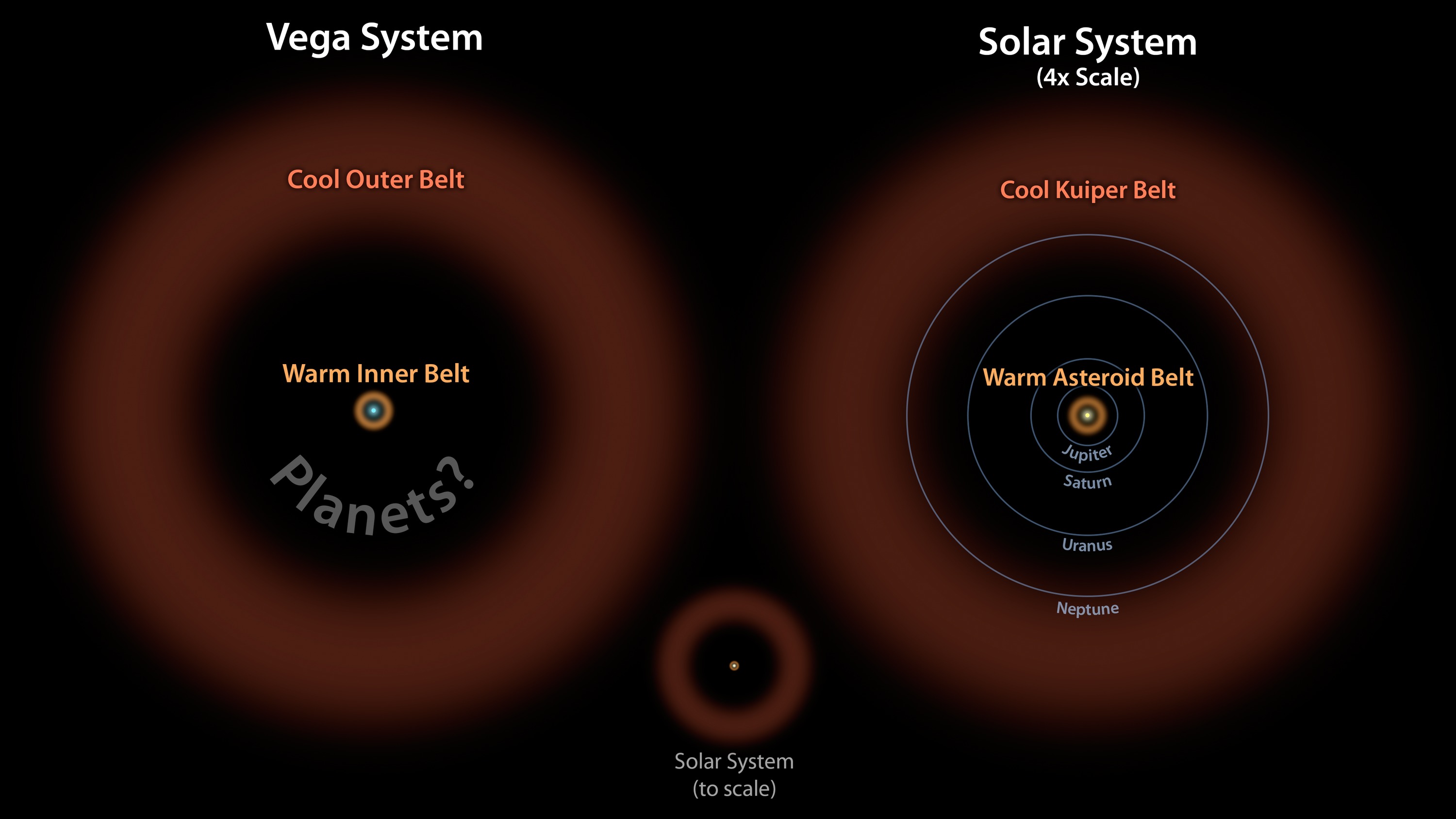
Now, it’s not exactly a shock that there would be new features revealed by new generations of observatories. After all, that’s often the whole point behind why we build them: to find, identify, and characterize features that go beyond the instrument limits of all prior observatories. It’s why it’s so important that we observe the closest examples of classes of objects in order to better measure their properties, and it’s why we have to hold onto a wide variety of examples of objects, including the unusual outliers that we see, if we want to obtain a comprehensive understanding of such systems.
For example, we’ve looked at GW Orionis, and found evidence for planets, as well as disconnected ringed debris features that orbit around all three stellar members within this system. We’ve looked at large numbers of planetary systems still in various stages of formation with ALMA, and discovered just how ubiquitous these features are: disks with gaps in them, indicating planets, as well as large amounts of mass still present in the dusty portions of the disk, often hundreds of times the mass of planet Earth.
What we’ve found is that planet-formation, and the presence of features in such disks, appears to be inevitable so long as enough time has passed since nuclear fusion first ignited in that star and so long as there is a sufficient abundance of heavy elements within the star in question.
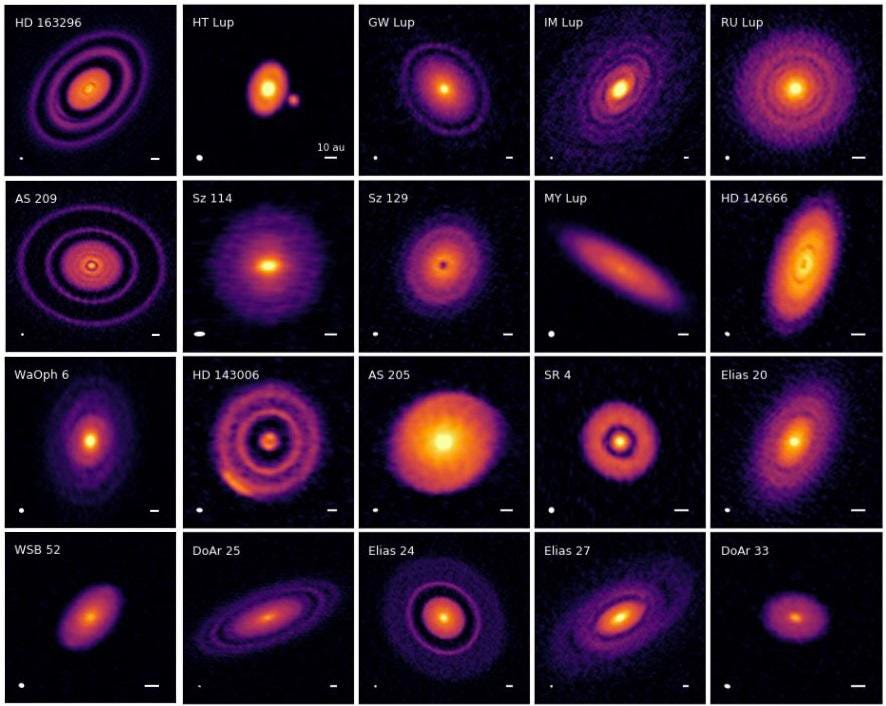
You might wonder, though, if this “general picture” truly applies everywhere, or whether there are exceptional systems out there that defy this inferred trend. Perhaps, you might wonder, whether the other Fomalhaut-like systems are all either like Fomalhaut (with three belts and many gaps) or like our own Solar System (with two belts and eight major planets), or whether there are other examples for even the general configurations that stellar systems and their planets can take on. Are there one-belt or no-belt systems out there? Are there four-belt or more systems that abound? Are there heavy-element-rich systems that don’t appear to have any planets at all around them?
As is often the case, these questions are indicative of questions we should always be asking, even when we don’t have the necessary resources at our disposal to answer them. We should keep our minds open to a wide variety of possibilities, even when the data only indicates a small number of examples with a small number of represented solutions. We should remember to refrain from making assumptions about what should be there before we have a sufficient amount of data to show us what actually is there.
Of course, we don’t always successfully do this; the temptation to draw sweeping conclusions from the data we have is difficult to resist. But with Vega, we have a new example of a debris disk system, and with new Hubble observations as well as the first JWST observations, we now have something fascinating to consider.
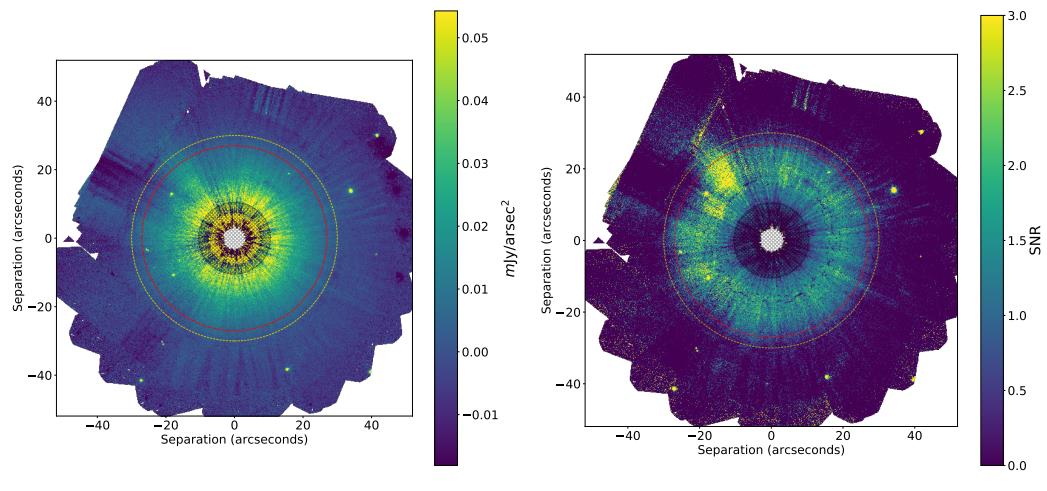
First off, the Hubble observations represent the deepest search we’ve ever done for scattered light around the Vega system. Because Vega is hot, close, and has a large debris disk around it (out to more than 170 astronomical units, or four times the distance to our Kuiper belt), and because the Hubble Space Telescope (like JWST) is equipped with a coronagraph, we can perform a set of steps where we:
- model the light from the star itself,
- model a dusty disk of debris with the appropriate thermal gradient,
- and then look for features, or imperfections, within that disk by subtracting the simple model from the actual data.
The team working on this was able to achieve the lowest surface brightness sensitivities to date: as little as 0.004 mJy/arcsec² (where the scale on the diagram at the above left is in mJy/arcsec² as well), and they do in fact detect evidence for a scattered light dust halo. If the halo is composed of small dust grains and extends from where the Hubble data indicates, from 80-230 astronomical units, then there’s no clear distinction between the parent planetesimal belt, previously observed by ALMA, and the extended dust halo.
This means that, despite the similarities between Fomalhaut and Vega in age, distance, brightness, and heavy element abundance, their disks, and the suspected presence of planets inside, are vastly different.
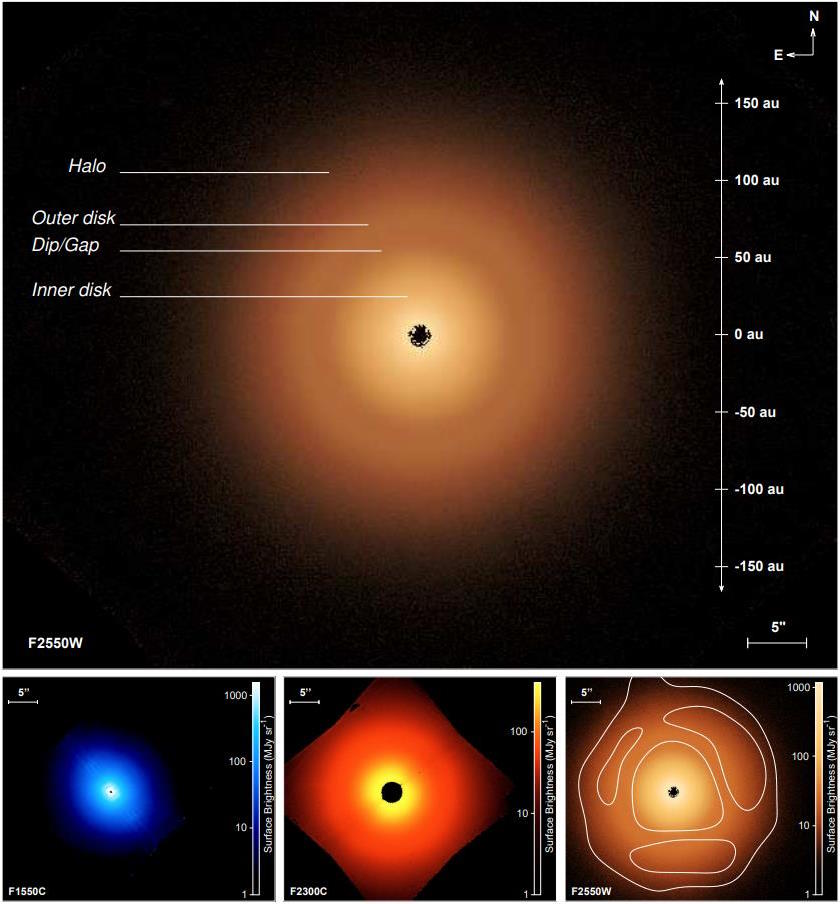
This set of differences only intensifies when we then add in the JWST data. Using multiple different photometric filters with the MIRI camera, the astronomers who measured this system with JWST were able to directly image the dusty debris around Vega, and what it found was as remarkable as it is surprising.
- First off, there is a planetary debris disk around Vega, and unlike the disk around Fomalhaut, it is smooth, symmetric, and centered on the star to great accuracy. This indicates that the disk is practically oriented face-on to us.
- Second, coincident with the ALMA data (that revealed a planetesimal belt) is a broad Kuiper-like ring that extends from ~80 astronomical units away from Vega all the way to ~170 astronomical units: one of the largest Kuiper-like belts ever seen.
- Third, interior to that belt is more smooth, symmetric debris, with only a very slight dip at about ~60 astronomical units away from Vega, potentially indicating a small, low-mass planet that must be much less massive than Saturn and that could realistically be no more massive than about ~6 Earth masses. (This is only about 30% the mass of Uranus or Neptune.)
- And finally, there is a boundary, or edge, to the inner disk of the Vega system that terminates about 3-5 astronomical units away from the star, consistent with where our own asteroid belt is located.
The big question then becomes how to interpret this data, or how to translate from these observations into what it means for the Vega system as a whole.
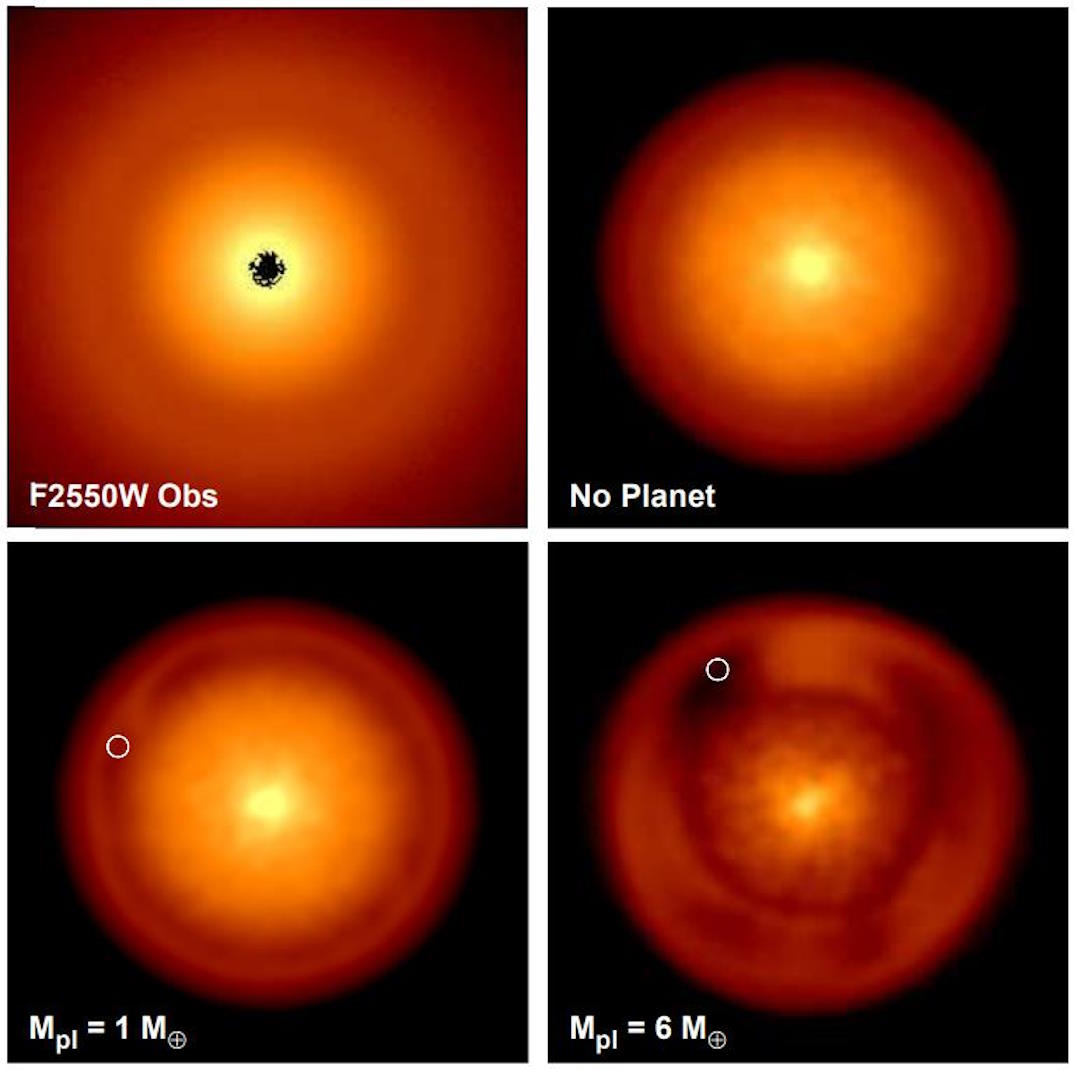
As far as planets go, the only evidence we have is:
- for one planet, much less massive than Saturn and probably no more massive than a mini-Neptune type world, located at a large ~60 astronomical units from the star, or about double the Sun-Neptune distance,
- and for a planet potentially as massive as Neptune (but also possibly less massive, or with larger numbers of planets) in the inner 3-5 astronomical units of this system, separating the inner edge of the warm debris from the hot zone closest to the star.
For the remainder of the system, from ~5 to close to ~60 astronomical units and, thereafter, from 80 astronomical units on out, there is no evidence for any other planets anywhere in this system.
By combining data from Hubble, ALMA, and JWST, scientists can infer that the halo of dust grains in the Vega system that’s interior to the broad outer belt are of a small but not sub-micron size, likely being dragged inward by the pressure exerted by solar radiation on dust grains of that particular size. (Astronomers call this the Poynting-Robertson effect.)
The part that’s most surprising? That we have a massive star, more than twice the brightness and size of our Sun, with a surface temperature of around 10,000 K and about 47 times as intrinsically bright as our Sun is, that’s already 700 million years old, and yet with no evidence for giant planets around it at all. Furthermore, there’s strong evidence against any Saturn-mass (or greater) planets within the Vega system at all. If you were playing exoplanet bingo, it’s very unlikely this one would’ve even been an option on any one player’s card.

So what’s going on? Where are all of the planets that one would have expected around a young, bright, massive star that already went through its planetary formation phase? Why is this disk so smooth and uniform, with so little hints of differentiation, save for one tiny “dip” (I hate to even call it a gap) at double the Sun-Neptune distance and one inner gap that could reveal up to a Neptune-mass planet at around the distance of either our asteroid belt or up to the distance of Jupiter?
I’ll say something that I’ve said frequently in recent months: this is the power that you only get by taking a transformational leap in your observing capabilities. When you upgrade from an instrument like Spitzer (with less than 10% of JWST’s resolution and under 1% of its light-gathering power) to one like JWST, the novel technical capabilities bring along with it an enormous amount of discovery potential: the ability to discover new objects, phenomena, or features that would have otherwise been invisible to all past observatories. The reason you build telescopes like JWST isn’t because of what you know you’ll be able to find, but rather because of what types of measurements you know you’ll be capable of, and because of what those measurements might enable you to uncover about nature itself.
Just weeks ago, we didn’t know what to make of Vega or what questions to be asking. Now, it’s clear we need to be asking, “Why and how are there no large planets plowing through this debris disk?” Planet formation is expected to begin no later than 2 million years into a star’s lifetime, and is expected to largely complete by ~10 million years into a star’s life. But here we are, some ~700 million years after the formation of Vega, and there’s scant evidence of any planetary structure at all.
Why? How? Is this common or rare? And what is the full variety of the types of planetary systems that are out there? In the JWST era, we’re finally learning what the right questions are to be asking. The answers, whatever they may be, will have to await future observations before we can uncover them.





